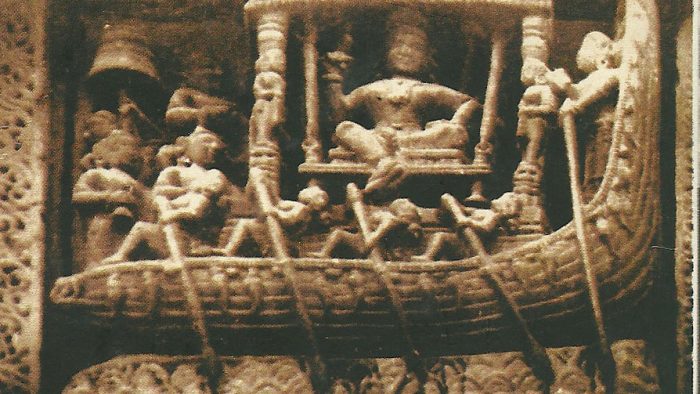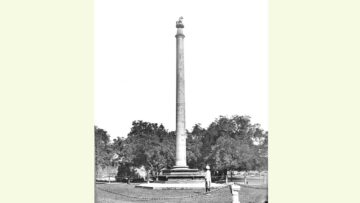Introduction
Today we live in a world where the whole global economy is dominated by multinational companies and complex corporate organisations. However, are we aware that corporate bodies have a hoary history in India? These corporate groups of merchants and artisans following a common profession have played a very active role in the economic set up of ancient India. The whole manufacturing sector and trade networks were controlled by these guilds. In English they are known as mercantile guilds and the Sanskrit and Pālī equivalents of this term are śreṇī, nigama, gaṇa, saṁgha and vrāta. Apart from economic functions, these guilds were also involved in making acts of charity to religious institutions like Buddhist Monasteries.
Understanding the meaning of the term Śreṇī
The word śreṇī is met with in the Ṛg Veda but it is used to mean a line or a sequence but in the Vedic corpus it is also used to denote the life ways of a group. In Paṇini’s Aṣṭādhāyī the word śreṇi denotes a guild. Pāṇini refers to commercial guilds as saṁsthāna and a merchant who was a member of such a guild was known as a saṁsthānika. The Itihāsas Rāmāyaṇa and Mahābhārata use the word ‘śreṇī’ to mean a guild. Certain commentators speak about a śreṇī as a group of people following the same occupation without any allusion to the caste of its members. On the other hand, some correlate a sreṇī with caste. Considering the different references to śreṇis the general meaning of this term was an economic organisation of people pursuing a common profession.
Reasons for the rise of guilds
- Investing money collectively for production purposes has been a very old practice in India. People who practised the same profession arranged themselves into guilds and this also gave them an upper edge at the ruler’s court. Also the merchants would go on very long and hazardous journeys where there was a high possibility of a mishap or an attack by bandits or even wild animals. Travelling as a guild gave the merchants more safety.
- The formation of guilds could also be an outcome of the varṇa vyavasthā. People following a common occupation were grouped in one varṇa. Out of this vocation based division of society, several sub-groups of people engaged in similar kind of work may have organised themselves into guilds
- Craft production was generally restricted to a specific locality and generally all craftsmen who were involved in it would reside in that particular area. This concentration of craftsmen in a single locality helped the junior ones to learn the craft with more ease. This also helped in guilds securing their own identity on the basis of their craft and locality.
- As the professions in India became more or less hereditary by the later Vedic age, the elder members of the family passed on their know-how about their craft to the younger members. This created a high number of craftsmen in the same family. It is possible that the members of a family with expertise in a particular craft or trade could have formed guilds for more smooth operation of their businesses.
- The urbanisation in the Gaṅgā Valley around the 7th- 6th centuries BCE was the consequence of surplus production. Since food was now easily available in comparison to earlier times, at least some people in the society could take up manufacturing and trading of goods as full-time occupations. The use of iron helped the growth of crops as well as manufacturing of better-quality goods. The rise of cities further accentuated handicraft industries and trade and the craftsmen and traders organised themselves into guilds for more efficient manufacturing and exchange of goods.
- Formation of the sixteen Mahājanapadas in the 6th century BCE helped in better political and economic stability. Trade routes which cut across the states emerged which helped in connecting cites and market towns across the Indian subcontinent. Traders now became aware about the sources of raw material as well as the kind of products which were in demand in local as well as distant markets. This increase in demand for better goods necessitated highly skilled craftsmen which could be provided by the guilds.
Historical Evolution of Guilds
Origin of Guilds
The origin of guilds in Ancient India is a little difficult to determine. Given the technical and economic advancement of the Sindhu-Sarasvatī Civilisation (SSC), there must have been some organisation of merchants and craftsmen. Craft specialisation like the manufacture of a wide variety of beads, pottery, bricks, seals and tools must have been possible only with some kind of formal economic system. The numerous seals discovered at the SSC sites belonged to merchants or their organisations. However, in the absence of substantial evidence, nothing can be said conclusively about guilds in the SSC. There are differing views about the existence of guilds in the Vedic period. However, K K Thaplyal states that in the later Vedic period, there may have been some kind of guild organisation. In the Ṛg Veda the Paṇis are mentioned who were a class of traders through we are not certain whether they were organised into guilds. There is a reference to guilds in the Bṛhadāraṇyaka Upaniṣad which gods who belonged to the Vaiṣya gaṇasaḥ and which meant that the Vaiṣyas earned their living through corporate activities. We must understand that the literature of the later Vedic period carries ample references to specialised crafts like an iron smelling, jewellery making and pottery and we may assume that people involved in these wide variety of crafts were organised into groups or guilds.
Guilds from 600 BCE to the Mauryan Age (320 BCE)
The 6th century BCE is a landmark in Indian history. It was the time when the Gaṅga plain experienced its first urbanisation and unprecedented levels of economic, political and religious transformations. At that time there were sixteen independent kingdoms or Mahājanapadas which have been listed in Buddhist and Jaina literature. It was also the age when two new religious thoughts arose- Buddhism and Jainism which greatly encouraged trade and commerce and had a large following from the mercantile community. Trade was regarded a high profession (ukkattha karma) in Buddhism. Two well known śreṣṭhins of that period were Anāthapiṇḍaka and Ghoṣita who constructed monasteries for the Buddha at Śrāvasti and Kauśāmbī respectively. The Gautama Dharmasūtra (5th century BCE) has the first clear reference to guilds. It states that farmers, merchants, cattle herders, moneylenders, and artisans are empowered to decide legal matters concerning members of their respective groups. (Gaut. Dhr.Sut. 10.21). Apparently, these guilds also had state recognition. The Jātaka Tales mention eighteen different kinds of guilds, craft industries and the principle of heredity introduced in vocations. The organisation of craftsmen into guilds also contributed towards craft specialisation. As per the ten markers of urbanisation given by archaeologist V.G. Gordon Childe, crafts specialisation was one of them and in the Indian context too, urbanisation and crafts specialisation were closely inter linked. The Jātaka tales and other Buddhist works mention sreṣṭhins or the heads of guilds repeatedly. Many of these head craftsmen or traders were ardent followers of the Buddha and made generous donations to the Buddhist Saṅgha.
Guilds from 320 BCE-200 BCE
This period coincides with the rise, climax and downfall of the Mauryan Empire. Trade and commerce were largely controlled by the Mauryan State and so were other economic activities like agriculture. The Mauryan state also regulated the natural resources which were used as raw materials in the production of goods. Accounts were to be maintained about the management of raw materials, the growth of factories as well as the traditional norms of the saṅghas or guilds and government regulations on them (A.S.2.7.2). From the Arthaśāstra we can understand that there were guilds of labourers which provided the work force (A.S. 3.14.12). All members of the guilds had to equally divide the earnings amongst themselves and the amount of the share was pre-determined (A.S.3.14.18). The Arthaśāstra also recommends that areas near the fortification of the city which are not inhabited should be given to guilds and foreign traders (A.S. 2.14.16). Guilds also gave loans to individual merchants. K K Thaplyal is of the opinion that because of the expansion of the Mauryan Empire many Gaṇasaṅghas lost their independence and some of them may have may have resorted to other occupations to earn their living. The Arthaśāstra has references to Kṣatriya śreṇīs of Kāmbhoja and Surāṣtra practising agriculture and trade. The system of guilds had become was well established and formalised by the Mauryan period.
Guilds from 200 BCE – 300 CE
This period corresponds with the rule of dynasties like the Suṅgas, Indo-Greeks, Śakas, Kuṣāṇas and Sātavāhanas over the Indian subcontinent. This was also the time when India had strong trade relations with the Roman Empire and the Indian Economy greatly benefited from this trade. Compared to the Mauryan period, guilds began to enjoy more autonomy and power. Their numbers also increased and this is reflected in the reference to as many as twenty four guilds in the Buddhist text called Mahāvastu. Inscriptions from Buddhist sites like Bhārhut, Sāñcī, Bodh Gayā and Mathurā as well as the Buddhist Caves from the Deccan have numerous references to donations being made by people belonging to different vocational groups. These include farmers, potters, garland makers, jewellers, traders and caravan leaders or sārthavahas. There is a reference at Sāñci to a donation made by a guild of ivory makers. Many of these individuals might have been members of guilds. Guilds of flour makers, oil pressers, weavers, potters and bankers also find mention in contemporary inscriptions. The large flow of donations indicates the high level of prosperity which the Indian Economy had reached. In other words, guilds were also engaged in several charitable works and people would even invest money with the guilds, the interest of which was used for food, clothes and medicines for the Buddhist monks. In all probability guilds also started issuing their own coins in this period. The rise of mercantile and craftsmen’s guilds is reflected in the Dharmaśāstra texts like the Manu and Yājñavalkya Smṛtis which are roughly dated to the same period.
Guilds from 300 CE to 600 CE
This period of almost three centuries witnessed the rule of the Imperial Guptas in northern India apart from a number of small and large states in other parts of India. Though the trade with Rome slackened, there was a significant rise in the volume of trade with South East Asian countries. This was also the time when we see a further growth of craft specialisation. The sculptures and teracottas of this period are fine examples of a very high level of artistic expression. The same can be said about the coins of the Guptas as well. Literature of the Gupta period indicates an expansion of the activities of guilds. The banking functions of guilds also increased and they continued to direct their patronage towards temples and monasteries. The law books of this period have details about the functions and constitutions of guilds. Guilds have been also referred to in Kālidāsa’s Raghuvaṁśa and Varāha Mihira’s Bṛhat Saṃhitā. The Vasudevahiṃḍī, which is a Jaina text also contains references to guilds. The guild system helped the merchants and artisans earn good profits in trade and business. There is a reference in the Vasudevahiṃḍī, to a saṅgha or guild of carpenters and the king accomplising his work through them. A guild of goldsmiths is also mentioned. Guilds also had a lot of influence on the king and the members of the nigama were a part of the jury while trying cases involving traders. The head of śreṇī or nigama i.e. the śreṣṭhin was considered equal in power with the king’s ministers. Guilds which provided garlands, betel-nuts and wines to the royal household had close links with the palace. Epigraphs of the Gupta period also refer to guilds of oil pressers and silk weavers. The seals discovered at Vaiśālī have the terms śreṣṭhin and nigama which could suggest some guild activity.
Concluding Remarks
We studied the evolution of guilds from the earliest times till the dawn of the 7th century CE. Guilds began to gradually decline from the post Gupta and specially from early medieval period onward. Nevertheless, they contributed immensely towards the flourishing Ancient Indian Economy. Trade in ancient India could prosper mainly because of these guilds. The economic functions of guilds with special emphasis on their bank like and charitable duties would be dealt in the next article.
References
- Jamkhedkar, A.P. Vasudevahimdi: A Cultural Study. New Delhi: Agam Kala Prakashan, 1984.
- Kangle R.P (Trans.), Kautiliya Arthashastra, Mumbai: Maharashtra Rajya Sahitya Sanskruti Mandal, 2011(Reprint)
- Maity S.K., Economic Life of Northern India in the Gupta Period. Calcutta: The World Press Private Limited, 1957.
- Majumdar, R.C. Corporate Life in Ancient India. Poona: The Oriental Book Agency, 1922.
- Nagarkar, Sneha ‘Corporate Religious Responsibility in Early Historic India’ in aWEshkar, Volume XIV, Issue 2, September 2012, pp.41-51.
- Olville, Patrick (Trans.) Dharmasutras: The Law Codes of Ancient India. Oxford and New York: Oxford University Press, 1999.
- Thaplyal, K.K. Guilds in Ancient India. New Delhi: New Age International Limited, 1996.
Disclaimer: The opinions expressed in this article belong to the author. Indic Today is neither responsible nor liable for the accuracy, completeness, suitability, or validity of any information in the article.










